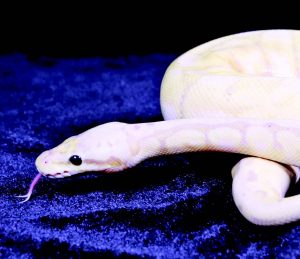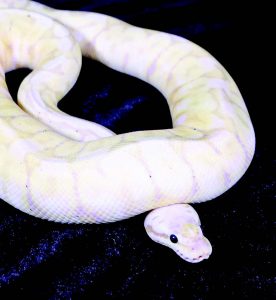Ball pythons—known to scientists as Python regius—are the most commonly kept snakes, and are pretty popular as pets in general. Could it be the beady little eyes, or the perfunctory sniffs they seem to take of everything? Could it be the way they curl up in the crook of their owners’ arms? Who knew snakes could be so sweet?!
Okay, well, that could be a misconception. But there’s no denying that this train of thought is all over the internet. Either way, we’re still running along on this reptile road as we look at the Banana Pewter Bee Ball Python. (Try saying that ten times fast.)
They Got it from their Momma
The name is just one of the cutest things about it—at least to snake lovers—and like most other morphs, simply denotes the color and pattern of the python. In this case, “banana” is for the dominant yellow hue it sports; “pewter” for the grayish-browns of its pattern, taken from a parent of the Cinnamon variety as a co-dominant. The latter might make this particular morph more desirable, in fact, because getting the almost elegant look of the Cinnamon is pretty unusual.
Nothing significant differs among morphs in terms of behavior, so you’re pretty much only searching for ones you like the look of. Among python lovers, though, there are certain patterns that just don’t occur in the wild, requiring very purposeful breeding, some trial and error, and a bit of patience, making these visual traits all the more desirable.
The Parent Trap (Alternatively: Third Times The Charm)
The primary concern, of course, is healthy eggs and baby snakes. A year-and-a-half old male ball python should just start to show that it is sexually active, while a female should be about two and a half years old, if not three. A healthy female should have some heft—about 1.5 kilograms. Still, it takes time, because simply shoving them in a tank together doesn’t guarantee eggs, let alone healthy ones. It’s expected that their first mating season won’t be successful.
So for all that, it’s still almost a kind of game, this ball python morph breeding, and largely one of chance—more accurately, probability. Healthy eggs often don’t come until around a snake’s third mating season. But it is the fact that it has become something of a game means that there are plenty of those who play it. Plain English: people love snakes now as they might love a dog or a cat, which is a relatively huge leap from where we were not too long ago.
Baby, Itssss Cold Outsssside
If the words “banana pewter bee” don’t already give you a case of Cute-Aggression, you might be drawn to the deceptively sweet face of the ball python. And some may mistake their habit of ‘snuggling’ into warm parts of the human body as affection. Larry Tan sets us straight on this: yes, it’s adorable—unfortunately, it may be more out of necessity than affection, but we’ll never really know. We’ll go with affection, anyway.
We say that, at least, not in the same sense as one might experience with a furrier companion. But cold blood doesn’t a cold heart make—“It’s just a different bond,” says Dr. Lorelei Tibbetts, LVT, VTF. Reptiles in general haven’t had the centuries of experience of human cohabitants that, say, dogs have, so they’ve kept their baser instincts, as well as their own means of demonstrating emotional attachment. For aspiring snake-owners, it’s really just a matter of becoming familiar with their language, as it were.
 Scale-Lien vs Predator
Scale-Lien vs Predator
“Their feeding response [could sometimes] be perceived as hostile or aggressive,” explains our expert, “which is just a reaction when you open their tubs or tanks and they think food is being served. There are also the easily scared baby snakes, [who] respond by striking as a defense. Normally, they outgrow this.” But just like people or other animals, personalities differ, so it’s up to the owner to learn their own reptile and its attitude.
On the subject of other animals, ball pythons and corn snakes might have more to fear from your cats than the other way around. “They’re inquisitive… and playful. I believe the cat would come out on top,” Larry warns us. “[But] it’s really not that uncommon to have other pets. It’s a matter of compatibility.”
This appeared in Animal Scene magazine’s February 2018 issue.






